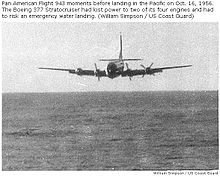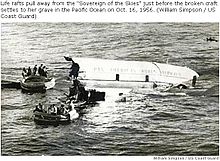Pan Am Flight 6
This article needs additional citations for verification. (March 2015) |
 Pan Am Flight 6 ditching in the Pacific Ocean, photographed from US Coast Guard Cutter Pontchartrain | |
| Accident | |
|---|---|
| Date | October 16, 1956 |
| Summary | Engine failure, ditching at sea |
| Site | Pacific Ocean Northeast of Hawaii 30°01.5′N 140°09′W / 30.0250°N 140.150°W |
| Aircraft | |
| Aircraft type | Boeing 377 Stratocruiser 10-29 |
| Aircraft name | Clipper Sovereign Of The Skies |
| Operator | Pan American World Airways |
| Registration | N90943 |
| Passengers | 24 |
| Crew | 7 |
| Fatalities | 0 human, 44 cases of live canaries |
| Survivors | 31 (all) |
Pan Am Flight 6 (registration N90943, and sometimes erroneously called Flight 943) was an around-the-world airline flight that ditched in the Pacific Ocean on October 16, 1956, after two of its four engines failed.
Flight 6 left Philadelphia as a DC-6B and flew westward on a planned multi-stop trip. It stopped at San Francisco International Airport, then flew onward to Honolulu. On the evening of October 15, 1956, the flight left Honolulu on a Boeing 377 Stratocruiser named "Clipper Sovereign Of The Skies" (Pan Am fleet number 943, registered N90943).
The accident was the basis for the 1958 film Crash Landing.
Accident details
The aircraft took off from Honolulu, Territory of Hawaii, at 8:26 p.m. HST on the flight's last leg to San Francisco. After passing the point of equal time, the flight received permission to climb to an altitude of 21,000 ft (6,400 m). When that altitude was reached, the No. 1 engine began to overspeed as power was reduced. The First Officer, who was flying the plane, immediately slowed the plane by further reducing power and by extending the flaps, and an attempt was made to feather the propeller. The propeller would not feather and the engine continued to turn at excessive RPM. The captain decided to cut off the oil supply to the engine. Eventually, the RPM declined and the engine seized. The propeller continued to windmill in the air stream, causing excessive drag that increased the fuel consumption. As a result, the plane was forced to fly much slower, below 150 knots (280 km/h), and lost altitude at the rate of 1,000 feet per minute (5.1 m/s). Climb power was set on the remaining three engines to slow the rate of descent. The No. 4 engine then began to fail and soon was producing only partial power at full throttle. At 2:45 a.m. the No. 4 engine began to backfire, forcing the crew to shut it down and feather the propeller.
The crew calculated the added drag left them with insufficient fuel to reach San Francisco or to return to Honolulu. In the 1950s the United States Coast Guard maintained a ship at Ocean Station November between Hawaii and the California coast. On that night, the ship was the USCGC Pontchartrain. The plane flew to the Pontchartrain's location, leveled off at 2,000 feet (610 m), and circled until daylight on the two remaining engines.
The captain decided to wait for daylight, since it was important to keep the wings level with the ocean swells at the ditching impact. As fuel burned off while the plane circled the Coast Guard cutter, the plane was able to climb from 2,000 to 5,000 feet (610 to 1,520 m). At that altitude several practice approaches were made to see that the plane would be controllable at low speed (the goal was to have the lowest speed possible, just before touching the water). Delaying ditching until daylight also made the plane lighter so it would float longer.
Aware of the Pan Am Flight 845/26 accident the year before, in which a Boeing 377's tail section had broken off during a water landing, the captain told the flight's purser to clear passengers from the back of the plane. The crew removed loose objects from the cabin, and prepared the passengers for the landing. As on other flights in the era, small children were allowed on their parents' laps, without separate seats or seat belts.[1] The captain planned to land near the ship in full sunlight, to improve the likelihood of rescuing passengers, but became concerned that the ocean waves were beginning to rise.
At 5:40 Captain Ogg notified Pontchartrain that he was preparing to ditch. The cutter laid out a foam path for a best ditch heading of 315 degrees, to aid the captain to judge his height above the water. After a dry run the plane touched down at 6:15, at 90 knots (170 km/h) with full flaps and landing gear retracted, in sight of the Pontchartrain at 30°01.5'N. 140°09'W.
One wing hit a swell, causing the plane to rotate, damaging the nose section and breaking off the tail. All 31 on board survived the ditching. Three life rafts were deployed by the crew and passengers that had been previously assigned to help. One raft failed to inflate properly, but rescue boats from the cutter were able to promptly transfer the passengers from that raft. All were rescued by the Coast Guard before the last pieces of wreckage sank at 6:35 a.m.
The passengers were housed in the ship's officers' quarters and returned to San Francisco several days later.[1]
There were a few minor injuries, including an 18-month-old girl who bumped her head during the impact and was knocked unconscious. Forty-four cases of live canaries in the cargo hold were lost when the plane sank.[1]
Flight crew
- Captain Richard N. Ogg, age 43.
- First Officer George L. Haaker, age 40.
- Navigator Richard L. Brown, age 31.
- Flight Engineer Frank Garcia Jr., age 30.
- Purser Patricia Reynolds, age 30.
- Stewardess Mary Ellen Daniel, age 24.
- Stewardess Katherine S. Araki, age 23.
Books and periodicals
- Adams, Michael R. (2010). Ocean Station: Operations of the U.S. Coast Guard, 1940-1977. Eastport, Maine: Nor'easter Press. ISBN 978-0-9779200-1-3. [Describes the ditching of Sovereign of the Skies and the rescue of its passengers and crew by the crew of USCGC Pontchartrain.]
- Brean, Herbert (October 29, 1956). "Ordeal On Flight 943: The Last Five Hours". Life: 23–30.
See also
- US Airways Flight 1549
- 1963 Aeroflot Tupolev Tu-124 Neva river ditching
- List of accidents and incidents involving commercial aircraft
References
- ^ a b c Matthew B. Stannard (2009-01-23). "Danville pilot has historical predecessor". San Francisco Chronicle.
External links
- Accident Investigation Report File No. 1-0121 U.S. Department of Transportation Archived Report
- Aviation Safety Network Description of the accident
- CAB Accident Report - Civil Aeronautics Board
- "HEROES: The Ditching." Time Magazine. Monday October 29, 1956.
- United States Coast Guard Video "Ready on Ocean Station November"
- Stannard, Matthew B. "Danville Pilot Has Historical Predecessor." San Francisco Chronicle. Saturday January 24, 2009.
- Crash Landing (1958) at IMDb
- Pan American World Airways accidents and incidents
- Aviation accidents and incidents in 1956
- Airliner accidents and incidents caused by mechanical failure
- Airliner accidents and incidents in Hawaii
- Disasters in Hawaii
- Airliner accidents and incidents involving ditching
- Accidents and incidents involving the Boeing 377
- 1956 in Hawaii



